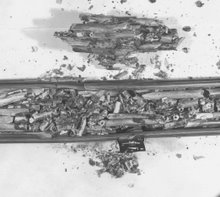Now, "wick boiling" is credited with occurring "In most circumstances ...".
The following may be more informative: The wick boiling assertion is likely traceable to a proprietary report by EPRI that includes an evaluation of a sample of fuel element scale from River Bend Cycle 11. However, it is unlikely that NRC has reviewed the EPRI report as a topical report that may serve as a basis for plant licensing. And it is unlikely that the EPRI report has been incorporated in proprietary computer codes or versions of TRACE that reactor plant owners may use in licensing.
DeShon of EPRI did not use the term"wick boiling" in his presentation to ACRS during 2003. The proprietary EPRI report discussed above was issued later.
Transcript of ACRS Reactor Fuels Subcommittee - Open Session, September 30, 2003, pages 1-152/229-281. Following is from page 132:
6 You hear about crud. Crud is bad. Well,
7 not all crud is bad because having a little bit of
8 crud on your fuel surface actually enhances heat
9 transfer. It gets your subcooled boiling taking place
10 a little bit better. Subcooled nucleate boiling is a
11 much more effective heat transfer mechanism than
12 forced convection.
In the nuclear power business it has become convenient to refer to fouling and scale as crud. However, the nuclear power jargon does not change the impact of fouling and scale deposits. GOOGLE has several references that discuss "wick boiling." Here are four:
ScienceDirect - Journal of Nuclear Materials : A model of ...
Heat transfer takes place by wick boiling in which water flows through the porous deposit and evaporates into steam at the surface of chimneys. ...linkinghub.elsevier.com/retrieve/pii/S0022311506000729 - Similar pages
Received 4 January 2005; accepted 31 January 2005.
Abstract
A model is described for simulating thermal hydraulic and chemical conditions within fuel crud deposits. Heat transfer takes place by wick boiling in which water flows through the porous deposit and evaporates into steam at the surface of chimneys. The transport and chemistry of dissolved species within the deposit is also modelled. This chemistry includes the equilibrium chemistry of Li/boric acid species, the equilibrium chemistry of Fe/Ni species and the radiolysis chemistry of water. The unique feature of this model is that the chemistry is coupled to the thermal hydraulics via the increase in the saturation temperature with the concentration of dissolved species. This has a profound effect on evaporative heat transfer within thick deposits, leading to conditions that explain the precipitation of LiBO2 and the possible formation of bonaccordite. The model helps understand several crud scrape observations, including why AOA is observed to occur for a crud thickness in the region of 20–30 μm.
Energy Citations Database (ECD) - Energy and Energy-Related ...
2) Without considering the concentration effect, wick boiling nullifies the thermal resistance due to the crud deposit and, therefore, ...www.osti.gov/energycitations/product.biblio.jsp?osti_id=6928828 - 14k - Cached - Similar pages
[PDF]
American Nuclear Society winter meeting; 15 Nov 1987; Los Angeles, CA, USA
Abstract
Boiling heat transfer occurs throughout most of the core of boiling water reactors, and at specific core locations in pressurized water reactors (PWRs).^For higher burnups, waterside corrosion of cladding may become a life-limiting feature of fuel rod design, especially when combined with daily load-following operation.^Corrosion of Zircaloy has been extensively investigated.^The major highlights gained from this study include the following: (1) in the absence of boiling, the presence of crud deposits increases the temperature at the Zircaloy/oxide interface and, therefore, accelerates Zircaloy corrosion dramatically, especially for thick crud layers.^(2) Without considering the concentration effect, wick boiling nullifies the thermal resistance due to the crud deposit and, therefore, mitigates significantly the acceleration of Zircaloy corrosion due to crud deposit.^(3) With the presence of LiOH, the concentration effect in the crud deposit due to wick boiling can be very detrimental to the Zircaloy corrosion resistance performance.^(4) The model prediction agrees in trend with limited plant data.
Modeling and Thermal Performance Evaluation of Porous Crud Layers ...
File Format: PDF/Adobe Acrobat - View as HTMLchimneys, an equivalent cylindrical region approximates the surrounding porous. region. Fig. 3. Schematic of the Wick Boiling in the Unit Cell ...www.osti.gov/bridge/servlets/purl/841238-rIfms9/native/841238.pdf - Similar pages
Note: The above reference, June 2005, may be viewed (in total) online. There is no claim that wick boiling enhances the heat transfer of fouling deposits.
A New Model for the Effect of Calcium Sulfate Scale Formation on ...
The transient change in heat transfer is closely related to wick boiling, and the associated changes in bubble departure diameter and bubble site density. ...link.aip.org/link/?JHTRAO/126/507/1 - Similar pages
April 2004
Abstract
Scale deposition on the heat transfer surfaces from water containing dissolved salts considerably reduces fuel economy and performance of heat transfer equipment. This problem is more serious during nucleate boiling due to the mechanisms of bubble formation and detachment. Using a precision pool boiling test apparatus, the effects of heat flux and calcium sulfate concentration on heat transfer coefficient and formation and growth of deposits are investigated. The transient change in heat transfer is closely related to wick boiling, and the associated changes in bubble departure diameter and bubble site density. A physically sound prediction model was developed for the prediction of heat transfer coefficients as a function of time during deposition processes. Based on comparison with experimental data over a wide range of foulant concentrations and heat fluxes, the model is considered to be sufficiently accurate for practical application. ©2004 ASME
None of these four papers claim that wick boiling is a practical long-term enhancement of heat transfer with fouling deposits. The second reference (1987) may come close to this for a very limited case. The final reference may be the most credible with its application of precision pool boiling test apparatus. It observes that with nucleate boiling the problem with scale deposition is more serious.

No comments:
Post a Comment